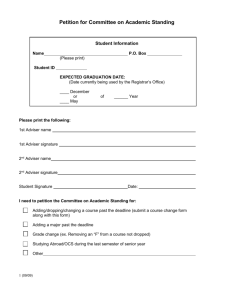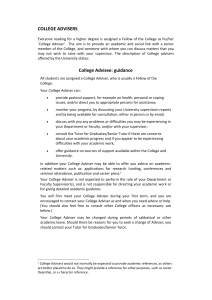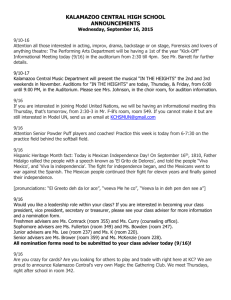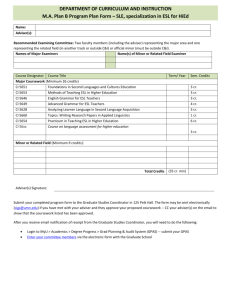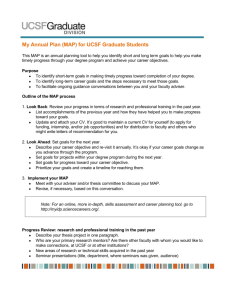Exam2-KEY - Central Washington University
advertisement
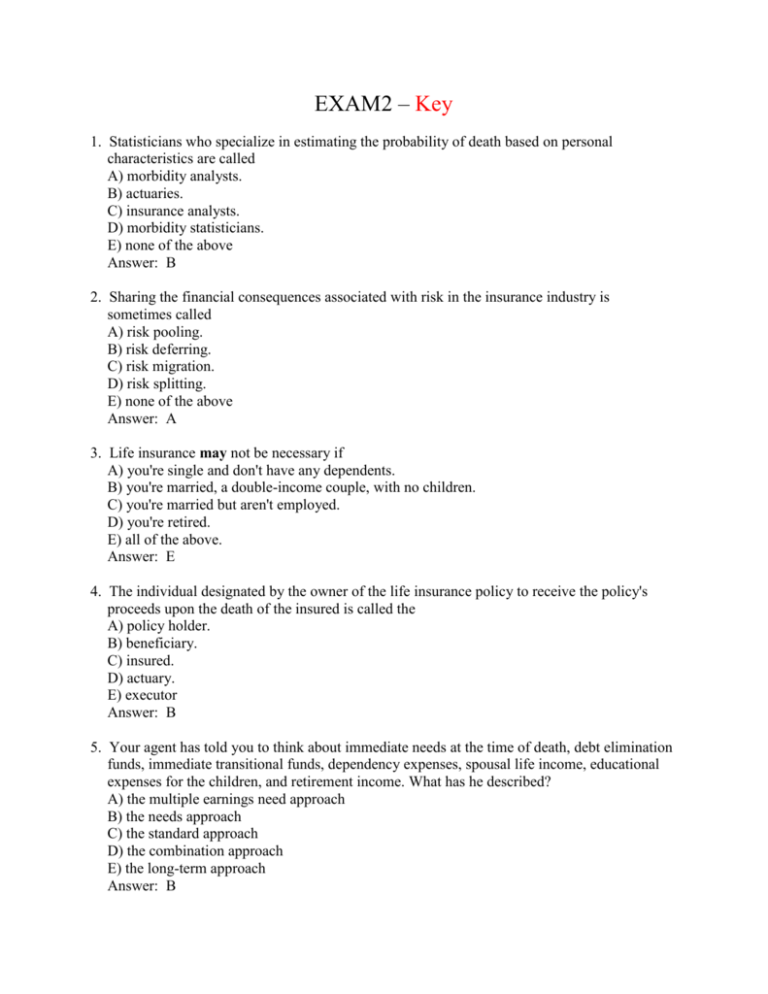
EXAM2 – Key 1. Statisticians who specialize in estimating the probability of death based on personal characteristics are called A) morbidity analysts. B) actuaries. C) insurance analysts. D) morbidity statisticians. E) none of the above Answer: B 2. Sharing the financial consequences associated with risk in the insurance industry is sometimes called A) risk pooling. B) risk deferring. C) risk migration. D) risk splitting. E) none of the above Answer: A 3. Life insurance may not be necessary if A) you're single and don't have any dependents. B) you're married, a double-income couple, with no children. C) you're married but aren't employed. D) you're retired. E) all of the above. Answer: E 4. The individual designated by the owner of the life insurance policy to receive the policy's proceeds upon the death of the insured is called the A) policy holder. B) beneficiary. C) insured. D) actuary. E) executor Answer: B 5. Your agent has told you to think about immediate needs at the time of death, debt elimination funds, immediate transitional funds, dependency expenses, spousal life income, educational expenses for the children, and retirement income. What has he described? A) the multiple earnings need approach B) the needs approach C) the standard approach D) the combination approach E) the long-term approach Answer: B 6. John purchases a life insurance policy on his wife Betty where he pays the premium and he will receive the life insurance money when she dies. John is both the ________ and the ________ who will receive the ________ upon the death of Betty, the ________. A) insured; beneficiary; money; policyholder B) policy owner; beneficiary; face amount; insured C) policy owner; insured; face amount; beneficiary D) beneficiary; premium payer; face amount; policy holder E) none of the above Answer: B 7. With decreasing term insurance A) the premiums remain constant, but the face amount of the policy declines. B) the premiums decline, and the face amount of the policy declines. C) the premiums remain constant, and the face amount of the policy remains constant. D) the premiums decline, and the face amount of the policy increases. E) the premiums decline, and the face amount of the policy remains constant. Answer: A 8. What are the advantages of term life insurance? A) It allows you to increase your insurance coverage for specific reasons and specific time periods. B) With decreasing term coverage, your premiums get smaller as you get older. C) It has no investment feature so it costs less than other forms of insurance. D) all of the above are correct. E) Only A and C are correct. Answer: E 9. The settlement option that provides for ongoing payments for a period of time is called ________. A) an annuity B) a reverse premium C) a premium payout D) an annual premium E) limited premium Answer: A 10. What is the purpose of companies such as A.M.Best, Moody's and Standard & Poor's? A) They sell life insurance directly to consumers without agents. B) They evaluate and rate the financial stability of the insurance industry. C) They provide reinsurance coverage to the insurance industry. D) They sell low cost term insurance via the Internet. E) None of the above Answer: B 11. Barry Blair wants to select a good life insurance agent. His dad has had several negative experiences with life insurance agents in the past. What should Barry consider when selecting an agent? A) has a professional designation B) is a full-time agent C) has the necessary experience and training D) has references E) all of the above Answer: E 12. Suppose that you earn $50,000 annually. You expect expenses to drop by 22% for your family in the event of your death. Currently, if you die, you want to provide for your family for at least 15 more years, and the applicable after-tax and inflation return assumed is 5%. Using the earnings multiple approach provided in your textbook, what would be the amount of life insurance that you should purchase? A) $301,080 B) $404,820 C) $485,940 D) $500,000 E) 519,000 Answer: B 13. A ________ is a savings plan offered by some employers that allows each employee to have pretax earnings deposited into a specially designated account for paying qualified medical and dependant care bills. A) medical distribution account B) planned provider account C) group practice plan D) flexible spending account E) planned reimbursement account Answer: D 14. Suppose that you wanted to purchase insurance that is sold by a private insurance company that will help bridge the gap in your Medicare coverage. You would purchase what type of insurance? A) Medicare Additional insurance B) Medigap insurance C) Medicare Plus insurance D) Medicare Bridge insurance E) none of the above Answer: B 15. Your health care coverage is with a PPO. For approved, in-network providers your deductible is $500 and your coinsurance provision is 80%. For out-of-network providers, your deductible is $1,000 and your coinsurance provision is 70%. Assume there is no co-pay provision and you have no other claims this calendar year. You have decided to go to a specialist that is not in the network and the bill is $1,400. How much will you have to pay out-of-pocket? A) $1,400 B) $1,120 C) $420 D) $1,320 E) $1,280 Answer: B 16. For every $100 set aside in a flexible spending account, taxable income is reduced by A) $10 B) $25 C) $50 D) $100 E) Not enough information available. Answer: D 17. Veronica was recently diagnosed with a heart condition. Her doctor's bill was $4,200 for the diagnostics. Her policy has a $250 deductible and a 80/20 coinsurance provision up to $10,000 and then the insurance pays 100% thereafter. In total, how much will Veronica pay for her diagnosis? A) $250 B) $4,200 C) $1,040 D) $10,000 E) $3,410 Answer: C 18. John Murphy experienced a freak storm that damaged his roof and allowed water to leak into the house. The agent and adjuster said the peril was not covered under his HO-2 policy. John wishes he had taken out an ________ policy. A) HO-1 B) HO-3 C) HO-4 D) HO-5 E) HO-6 Answer: B 19. John Meadow rents an apartment and wants tenant's insurance or an ________ policy. A) HO-1 B) HO-2 C) HO-3 D) HO-4 E) HO-6 Answer: D 20. Your boyfriend is living in an apartment complex that has had a recent rash of robberies. He has $5,000 worth of rare coins. What should he do to protect himself in case of a robbery? A) Take a written and video tape inventory of his property. B) Add a personal articles floater to his policy. C) Take out personal property replacement cost coverage. D) Only B and C above E) A, B, and C above Answer: E 21. The purpose of a personal umbrella policy, as an addition to your homeowner's policy, is primarily to protect you from A) acts of God, such as falling objects, hail, etc. B) flood damage. C) lawsuits and judgments. D) faulty construction of your home. E) contested title to your property. Answer: C 22. The disadvantage of actual cash value coverage of personal property compared to replacement cost coverage is that it A) will reimburse you for replacement cost minus estimated depreciation. B) will reimburse you for the cash value of a new item. C) must be reported as a loss on your tax return. D) does not have to be reported as a loss on your tax return. E) none of the above Answer: A 23. Supplemental coverage for homeowner's insurance is available through endorsements. Which one of the following is not a common form of additional coverage? A) personal articles floaters B) earthquake coverage C) flood protection D) medical payments E) inflation guard Answer: D 24. Lisa and Eric want to keep the cost down on the homeowner's insurance they will need. After talking to their parents they developed a list of ways to do so. Identify the one mistake on it. A) Take as high a deductible as you can afford to self insure. B) Install an adequate security system. C) Pay your insurance premiums quarterly. D) Install adequate smoke detectors. E) Insure your cars with the homeowner's company. Answer: C 25. You had several of your son's friends over last night for a sleepover. While dropping off their child, one of the parents did not see your basketball hoop and smashed it beyond repair with her car. Where would you look for damage payment? A) the driver's homeowner's insurance B) section II of the driver's homeowner's insurance C) the driver's automobile liability coverage D) the driver's automobile comprehensive insurance E) the driver's automobile collision insurance Answer: C 26. Which of the following is not a determinant of the cost of your automobile insurance rates? A) your age B) your credit score C) your driving record D) your marital status E) the number of children that you have. Answer: E 27. You were standing on the sidewalk waiting for a bus when a car lost control, jumped the curb, and hit you in the leg causing medical injuries. Which of the following provides reimbursement for your medical expenses? A) The driver's collision coverage. B) The driver's liability coverage. C) Your comprehensive physical damages coverage. D) Your medical expenses coverage E) Both B and D are correct. Answer: E 28. ________ auto insurance pays for your losses and the losses suffered by your passengers, while the other driver's insurance would pay for his or her losses. This arrangement is made to keep insurance costs down, especially for settling claims. A) Comprehensive B) No-fault C) Your fault D) PAP E) PIP Answer: B 29. Elvis drove expensive cars. Which of the following was not a determinant in his automobile insurance costs? A) type of vehicle B) his personal characteristics C) his driving record D) where he lived E) All of the above WERE determinants in the cost of his auto insurance. Answer: E 30. In your many travels, you have suddenly found yourself in an auto accident — the very first one where you are at fault. Both cars are blocking a bridge with heavy city traffic. What should you do? A) Stay at the scene of the accident — have someone call the police and get medical help. B) Move the cars to a safe place so no one else gets hit. C) Call a lawyer to meet you at the scene of the accident. D) Refrain from admitting guilt or signing anything. E) all of the above except C Answer: E 31. A client of yours who is in his mid-forties has a tendency to live beyond his means. He has just informed you that his lone surviving parent has just been diagnosed with stage 4 cancer. Your client stands to inherit close to $3,000,000 in the near future. Which of the following is the MOST important discussion to have with your client? (A) The purchase of an annuity (B) Establishing a budget (C) The tax ramifications of the inheritance (D) Establishing a trust D is the answer. The client is in his 40’s. Even though, the annuity would take care of the spendthrift tendencies, there would be the possibility of tax penalties and loss of flexibility in fund withdrawals. A budget must be adhered to and the client lacks discipline. There are no tax ramifications on the inheritance. A trust would allow control of withdrawals and flexibility. 32. In terms of disability planning which would be the most vital rider to a disability plan? (A) Extend the coverage to age 70 (B) Waiver of premium (C) Inflation clause (D) Period certain B is the answer. D is irrelevant as it is a type of insurance or annuity payout. A and especially C may seem appealing, but if the client is not working and medical expenses increase, she/he may not be able to maintain the premiums to receive the benefits. 33. A client of yours who is in his mid-forties has a tendency to live beyond his means. He has just informed you that his lone surviving parent has just been diagnosed with stage 4 cancer. Your client stands to inherit close to $3,000,000 in the near future. Which of the following is the MOST important discussion to have with your client? (A) The purchase of an annuity (B) Establishing a budget (C) The tax ramifications of the inheritance (D) Establishing a trust D is the answer. The client is in his 40’s. Even though, the annuity would take care of the spendthrift tendencies, there would be the possibility of tax penalties and loss of flexibility in fund withdrawals. A budget must be adhered to and the client lacks discipline. There are no tax ramifications on the inheritance. A trust would allow control of withdrawals and flexibility. 34. A drug that has been on the market for pain relief has been found that it is a possible hair growth stimulant. Which of the following are likely to happen? I Both supply and demand would go up II The price would stay the same III The price would go up IV The price would go down. (A) I and II (B) I and III (C) II only (D) IV only B is the answer. When both supply and demand increase, a new higher equilibrium price is achieved. 35. The two biggest college football rivals have gone through their respective season unbeaten. The winner of this game will be ranked the new #1 team. Which of the following will happen? I The price of a ticket would go up. II The supply of tickets would remain unchanged. III The price would remain unchanged. IV The demand for tickets would increase. (A) I and II only (B) II and III only (C) III and IV only (D) I, II, and IV only D is the answer. The demand curve would shift up, while the supply curve would stay constant raising the price of a ticket. 36. Big Toy Company who has this year’s hottest toy for the holiday just announced that one of its largest factories has been destroyed by fire. According to the laws of supply and demand, which of the following is the most likely scenario? (A) The price would remain the same (B) Increased demand will be the major factor in a price increase. (C) The price will go down because there are fewer toys to buy. (D) Demand can remain constant and the price will still rise. D is the answer. Demand does not have to increase for the price to go up. The supply has gone down .B is incorrect, because the cause of the price increase will be mostly due to reduced supply. 37. Over the past two months you have noted that the normal yield is starting to flatten out. The economic cycle is in what phase? (A) Early stages of expansion (B) Later stages of expansion (C) Early stages of recession or contraction (D) Trough B is the answer. The curve is starting flatten out because the Fed is raising short-term rates to slow down an economy that is starting to overheat. In the early stages of expansion, there will be a normal yield curve. 38. The economy has been lagging and the Fed would like to stimulate the economy. Which of the following actions is it most likely to taken by the Fed? (A) Raise the reserve requirement (B) Increase government spending (C) Slightly raise the discount rate. (D) Buy Treasury securities. D is the answer. A and C will be used to slow the economy. B would be used to stimulate the economy, but it is a fiscal tool used by the government (congress), not the Federal Reserve Board. 39. The unemployment rate is low and wages are high. Productivity numbers are slowing down while inflation is still edging higher. Which phase of the economic cycle are you most likely in? (A) Late stages of expansion (B) Early stages of contraction (C) Early stages of expansion (D) Late stages of contraction A is the answer. In the early stages of contraction, inflation will have peaked and may slightly be moving downward. Additionally, unemployment rates would be low but also starting to increase. 40. Which of the following is the most commonly used tool of the Federal Reserve Board? (A) Reserve requirements (B) Discount rate (C) FOMC open-market operations (D) Margin requirement C is the answer. Even though the raising and lowering of the discount rate is the most visible of the Fed’s tools, the Federal Open Market Committee (FOMC) buys and sells securities on a daily basis. This buying and selling of securities, called open-market operations, is the most frequently used tool of the Fed. 41. All of the following are Fiscal tools that may be used to stimulate the economy, EXCEPT: (A) Lower taxes (B) Borrow money (C) Increase government spending (D) Buy Treasury securities. D is the answer. Even though buying Treasury securities is a stimulus tool; it is monetary policy, not fiscal. 42. All of the following are used to explain a normal yield curve, EXCEPT: (A) Market segmentation (B) Efficient Market Hypothesis (C) Liquidity Preference (D) Expectations Theory B is the answer. The efficient market hypothesis deals with the market including information into the pricing of securities. 43. How much should Alexis pay for a bond that will mature in 3 years with a 7% coupon, if comparable bonds are yielding 9%? (A) $948 (B) $968 (C) $1,070 (D) $1,090 A is the answer. N = 6 (3 x 2); I = 4.5% (9 ÷ 2); PMT = 35; FV = 1,000; solve for PV which is $948. 44. What is Scott’s approximate yield to maturity on a bond that he purchased for $1,030, when it had 5 years until maturity and paid a 10% coupon? (A) 8% (B) 9% (C) 10% (D) 11% B is the answer. N = 10 (5 x 2); PV = –1,030; PMT = 50; FV = 1,000; solve for I, remembering to annualize it. 9.23%. 45. Joanne can invest $9,000 at compound interest of 8%. Approximately how long will she have to wait to have $18,000? (A) Seven years (B) Eight years (C) Nine years (D) Ten years C is the answer. According to the Rule of 72, the money will double in approximately 9 years (72 divided by 8 = 9). The answer can also be found on your calculator. 46. Susan can invest $25,000 for six years. According to the Rule of 72, approximately what rate of compound interest will she have to earn to double her money to $50,000? (A) 9% (B) 10% (C) 11% (D) 12% D is the answer. According to the Rule of 72, the money will double in six years at a rate of 12% (72 divided by 12 = 6) 47. Charles borrowed money from Peter a few years ago, and Charles is to repay the money, with interest, five years from today, an amount that will then be $8,000. However, Peter has just heard from his accountant that he (Peter) must pay a tax assessment of $4,500 tomorrow. Accordingly, Peter offers Charles the opportunity to pay $4,500 today rather than $8,000 five years from today. What annual rate of interest is Peter using in discounting Charles’s obligation? (A) Between 11% and 12% (B) Between 12% and 13% (C) Between 13% and 14% (D) Approximately 21% B is the answer. N = 5; PV = -4,500; PMT = 0; FV = 8,000; solve for I. The value of i is 12.19%. 48. Walter wants to deposit $1,500 into a certificate of deposit at the end of each of the next six years. The deposits will earn 5% compound annual interest. If Walter follows through with his plan, approximately how much will be in his account immediately after the sixth deposit is made? (A) $8,455 (B) $9,450 (C) $10,200 (D) $11,200 C is the answer. Set the calculator to end mode; N = 6; I = 5; PV = 0; PMT = 1,500; Solve for FV. FV = $10,203. 49. Cheryl plans to begin saving for her children’s education by depositing $2,500 today in a savings account. She plans to increase her annual deposits by 8% each year beginning one year from now. She will make a total of seven deposits, including the initial $2,500. If her account earns 6% interest per year, approximately how much will be in the account at the end of seven years? (A) $15,150 (B) $16,700 (C) $18,500 (D) $27,850 D is the answer. This is a two step calculation. Set the calculator for beginning-of-period payments. (Today is begin mode) Then calculate the adjusted discount rate and enter it into the calculator as the value of i. In this case it is negative and must be entered as such. 1.06 ÷ 1.08 – 1 x 100 = –1.8519 N = 7; I = -1.8519; PV = 0; PMT = 2,500; solve for PV which is $18,522. To find what the growth will be, enter 6 as the value of i and 0 as the value of PMT. Solve for FV, which is $27,850. 50. In three years, Kelly wants to take a year off from work to travel around the world. She believes it currently would cost $45,000, but it would increase 4% a year. Kelly anticipates she can earn 6% on her investments. Kelly has been able to save $10,000 so far. How much would Kelly need to save at the beginning of each month? (A) $289 (B) $306 (C) $482 (D) $491 C is the answer. Input the following variables: Begin mode N = 36 (3 x 12) I = inflation adjusted rate of return which is 1.9231 [1.06/1.04 – 1] x 100) PV = 10,000 (input as a negative number) FV = 45,000 Solve for PMT which is $482. 51. Which of the following persons must register under the Investment Advisers Act of 1940? (A) A publisher of a business magazine of general circulation (B) An adviser who advises only on U.S. government securities (C) A CPA who provides substantial investment advisory services (D) A broker who receives only commissions for sales and gives only incidental advice on securities C is the answer. Attorneys, CPAs, and other accountants (as well as engineers and teachers) are excluded or excepted from the Act’s registration requirements only if their advisory services are incidental to the practice of their profession. 52. Which of the following entities is excepted from the requirement to register with the SEC under the Investment Advisers Act of 1940? (A) Financial planners who sell less than $500,000 of securities per year. (B) Financial planners who give investment advice for a fee but do not sell any products. (C) A bona fide financial publication with general and regular circulation. (D) Investment advisers who provide advice concerning investing only in mutual funds for a fee. C is the answer. The Investment Advisers Act of 1940 provides an exception for a bona fide financial publication with general and regular circulation. Such a publication need not register as an investment adviser. 53. Registration of an investment adviser with the SEC is accomplished by: (A) filing FORM U-4. (B) passing a competency test. (C) filing FORM ADV. (D) filing FORM ADV-W. C is the answer. To register as an investment adviser, a person files Form ADV. A person selling securities must also register with FINRA by filing Form U-4. To register does not require passing a competency test. Form ADV-W is filed when an adviser ceases operations. 54. Which of the following statements concerning the restrictions imposed on performance-based fees is correct? (A) The fees may be charged if client-managed assets exceed $1,000,000. (B) The fees may be charged to any client, provided there is disclosure and the fees are “fair.” (C) Such fees may be charged if the client has a net worth of over $1 million (D) Performance fees are not allowed under any condition. A is the answer. Generally, performance-based fees are prohibited, because the fees encourage advisers to take greater risks to obtain greater returns. An adviser who manages over $1,000,000 in assets for a client or an adviser to a client with a net worth of at least $2 million, however, may base fees on a percentage of performance. 55. Which of the following statements is true of a “red herring” preliminary prospectus? (A) It may be sent to a potential customer prior to that person expressing an indication of interest. (B) It may be sent to a potential customer only after that person has expressed an indication of interest. (C) It may be sent only after the registration of the issue is effective. (D) It may only be sent with the confirmation of a sale. A is the answer. A “red herring” is a preliminary prospectus sent to anyone to obtain indications of interest prior to final registration. 56. Which of the following would be considered an "Investment Adviser” under the Investment Advisers Act of 1940? (A) A magazine of general circulation on investing. (B) A subscription letter by a well known market “forecaster” that renders advice on a customer’s specific situation. (C) A weekly economic forecasting report available by subscription only. (D) A daily newspaper column on personal investing. B is the answer. The person gives advice; is in the business of giving advice and is compensated for that advice. The difference between this and the other publications is the customer specific advice. 57. Which of the following are acceptable on your business card? I Frank Adviser, CFP®, RIA II Frank Adviser, CERTIFIED FINANCIAL PLANNER™, Registered Investment Adviser III Frank Adviser, Certified Financial Planner™, Registered Investment Adviser IV Frank Adviser, CFP®, Register Investment Adviser (A) I only (B) I and II only (C) II and IV only (D) II, III, and IV only C is the answer. CFP® and CERTIFIED FINANCIAL PLANNER™ are acceptable uses. Registered Investment Adviser must be written out. You cannot use the initials RIA. CERTIFIED FINANCIAL PLANNER™ must always be written in all capital letters. 58. Which of the following are components of the fiduciary responsibility? I Sell only suitable investments II The Client’s interest is placed before the planners’ III Act in accordance with the Prudent Man Standard IV Exercise diligence (A) I and II only (B) II only (C) II, III, and IV only (D) I, II, III, and IV D is the answer. Even though II is the definition of a fiduciary; all are components of a fiduciary responsibility 59. You have entered into contractual negotiations with another party. You agree with all of the provisions of the contract except one. You tell the other party that you will accept all of the provisions of the contract if they amend this one item. (A) You have made an acceptance of the offer. (B) You have made a tentative acceptance of the offer. (C) You have made a counteroffer. (D) You have given sufficient consideration to the offer. C is the answer by definition. 60. You and the principal you work for are at a holiday party. The principal points you (the agent) out to a group of individuals and tells them how much she trusts you to make “on the spot” judgment calls. The following week you meet with one of these individuals and agree to a specific request the would-be client has made. This is an example of: (A) Express authority (B) Implied authority (C) Apparent authority (D) Unauthorized act, ratified by the principal C is the answer by definition. 61. Bonus: Charlie graduated from school and took a job at the University of Washington as an Assistant Professor. He and his new wife found a nice little house in North Bend and took out a 30-year fixed rate mortgage for $400,000. Unfortunately the Federal Reserve’s easy money policy had finally taken its toll and the 30-year fixed rate had risen to 10%. If Charlie makes all of his payments on time and in full, how much will he still owe on the loan after four years of payments? A) $346,667 B) $231,506 C) $389,609 D) $248,356 C is the answer 62. Bonus: How much interest will Charlie pay on the 48th payment? A) $111 B) $351 C) $29 D) $3,249 D is the answer 63. Bonus: How much does Charlie pay towards the Principle on the 48th payment? A) $261 B) $3,159 C) $9 D) $1,100 A is the answer




